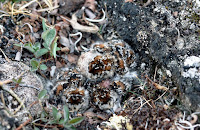BAIRD'S SANDPIPER
BAIRD’S SANDPIPER (Calidris bairdii) – (See images below)
DESCRIPTION: The Baird’s Sandpiper adult is mottled brown on top with a white belly and rump. Head, throat and breast are beige with brown streaks. Bill and eyes black, legs dark grey. Bill about same length as head. Wings longer than tail. Sexes are similar. Bird length about 18 cm (7 inches).
VOICE: https://www.xeno-canto.org/species/Calidris-bairdii
NAME: The English name ‘Sandpiper’ stems from ‘sand’, and Latin ‘pipa’, which means to ‘chirp’. The name ‘Baird’s’ in English (and Latin species name ‘bairdii’) was given to this bird in honor of American ornithologist Spencer Fullerton Baird. The Latin genus name ‘Calidris’ is from ancient Greek and refers to a grey speckled shorebird.
HABITAT: Dry tundra, mudflats, fields.
DIET: Insects, crustaceans.
NESTING: Nest is a shallow depression on the ground. About four pinkish eggs are laid, incubated by both parents. Chicks can feed themselves soon after hatching, but parents care for them.
DISTRIBUTION: Breeds in Alaska and western half of Canada tundra, migrates through western half of North America. Winters in South America, west side. Some individuals will reach Hawaii (see note below on bird vagrancy).
Distribution Map: https://en.wikipedia.org/wiki/Baird%27s_sandpiper#/media/File:Bairds_Sandpiper_Range.png
ON PEI: Does not breed on Prince Edward Island, rare in summer and fall during migration.
CONSERVATION: Population appears stable, not at risk.
SIMILAR SPECIES: White-rumped Sandpiper, Semipalmated Sandpiper, Pectoral Sandpiper, Western Sandpiper
Vagrancy: In biology this means an animal going way outside its normal range. For birds, this can happen when there are storms and they get blown off course. On other times, the bird simply wanders in a different direction than usual. Here’s an article about vagrancy in birds.
REFERENCES: https://en.wikipedia.org/wiki/Baird%27s_sandpiper http://fieldguide.mt.gov/speciesDetail.aspx?elcode=ABNNF11120 (Montana Field Guide)
https://www.audubon.org/field-guide/bird/bairds-sandpiper
https://www.allaboutbirds.org/guide/Bairds_Sandpiper/overview
https://identify.whatbird.com/obj/432/overview/Bairds_Sandpiper.aspx
https://www.borealbirds.org/bird/bairds-sandpiper
https://www.ctaudubon.org/2017/08/bairds-sandpiper/
DESCRIPTION: The Baird’s Sandpiper adult is mottled brown on top with a white belly and rump. Head, throat and breast are beige with brown streaks. Bill and eyes black, legs dark grey. Bill about same length as head. Wings longer than tail. Sexes are similar. Bird length about 18 cm (7 inches).
VOICE: https://www.xeno-canto.org/species/Calidris-bairdii
NAME: The English name ‘Sandpiper’ stems from ‘sand’, and Latin ‘pipa’, which means to ‘chirp’. The name ‘Baird’s’ in English (and Latin species name ‘bairdii’) was given to this bird in honor of American ornithologist Spencer Fullerton Baird. The Latin genus name ‘Calidris’ is from ancient Greek and refers to a grey speckled shorebird.
HABITAT: Dry tundra, mudflats, fields.
DIET: Insects, crustaceans.
NESTING: Nest is a shallow depression on the ground. About four pinkish eggs are laid, incubated by both parents. Chicks can feed themselves soon after hatching, but parents care for them.
DISTRIBUTION: Breeds in Alaska and western half of Canada tundra, migrates through western half of North America. Winters in South America, west side. Some individuals will reach Hawaii (see note below on bird vagrancy).
Distribution Map: https://en.wikipedia.org/wiki/Baird%27s_sandpiper#/media/File:Bairds_Sandpiper_Range.png
ON PEI: Does not breed on Prince Edward Island, rare in summer and fall during migration.
CONSERVATION: Population appears stable, not at risk.
SIMILAR SPECIES: White-rumped Sandpiper, Semipalmated Sandpiper, Pectoral Sandpiper, Western Sandpiper
Vagrancy: In biology this means an animal going way outside its normal range. For birds, this can happen when there are storms and they get blown off course. On other times, the bird simply wanders in a different direction than usual. Here’s an article about vagrancy in birds.
REFERENCES: https://en.wikipedia.org/wiki/Baird%27s_sandpiper http://fieldguide.mt.gov/speciesDetail.aspx?elcode=ABNNF11120 (Montana Field Guide)
https://www.audubon.org/field-guide/bird/bairds-sandpiper
https://www.allaboutbirds.org/guide/Bairds_Sandpiper/overview
https://identify.whatbird.com/obj/432/overview/Bairds_Sandpiper.aspx
https://www.borealbirds.org/bird/bairds-sandpiper
https://www.ctaudubon.org/2017/08/bairds-sandpiper/
 |
| Baird’s Sandpiper – Gullbringusysla, Iceland – photo by Ómar Runólfsson |
 |
| Well-camouflaged Baird's Sandpiper chicks - USFWS |
 |
| Baird’s Sandpiper, nonbreeding plumage La Laguna, Chile – photo by Dick Daniels |